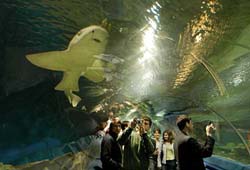04.28.2006 13:05
 By Yekaterina Dranitsyna
By Yekaterina Dranitsyna
Staff Writer
Last week saw the opening of two water-related attractions in St. Petersburg. As well as being unique to the region, it is hoped the projects will attract more tourists to the city.
On Tuesday the Waterville aquapark opened at the Pribaltiiskaya hotel on Vassiliyevsky Island. The city’s first aqua-park occupies an area of 14,000 square meters, of which water makes up 1,300.
Waterville director Vladislav Smirnov said that the company invested about $32 million into the park’s construction, Interfax reported Tuesday.
Smirnov expects over 1,000 people to visit the aquapark daily. A day ticket for adults will cost 700 rubles, for children — 490 rubles.
Waterville will operate throughout the whole year. The air temperature will be around 30 degrees, the water temperature — 28 degrees.
Waterville has six water slides and six pools, bars and restaurants, saunas, solariums, beauty salons, a fitness center, a sports shop and a children’s playroom.
“The idea behind the aquapark comes from the fact that St. Petersburg is a city of summer tourism. As part of attracting locals and tourists during the winter we identified an new niche in the market,” said the general director of the Pribaltiiskaya hotel Andrei Yakunin.
A local expert said that the aquapark would mainly attract Russian tourists from other regions.
“Finnish aquaparks are very popular among Russian tourists who live in St. Petersburg and the Leningrad Oblast. But for people living in eastern parts of the country it is inconvenient to get there and relatively expensive. Now they will receive all this in Russia and at much cheaper rates,” said Nikita Savoyarov, head of tourism consultancy ET Consult and expert at the Russian Tourism Industry Union.
It will become particularly popular if EU countries go through with their plans to increase the cost of visas from 35 euros to 60 euros from January next year, Savoyarov said.
To attract tourists from the regions, the Pribaltiiskaya hotel could offer package tours including hotel accommodation, a visit to the aquapark and several city museums; it could also sell season tickets for multiple visits, Savoyarov suggested.
As well as attracting tourists, the aquapark will provide work for entertainment companies and infrastructure operators, Savoyarov said.
Earlier this month the chairman of Smolny’s Committee for Investment and Strategic projects, Maxim Sokolov, said that 3.5 million tourists are expected to visit St. Petersburg in 2006. Last year 2.96 million people came to the city.
To increase the number of incoming tourists, local authorities will implement a “special information policy,” which includes the opening of representative offices in foreign countries, marketing campaigns, and the launching of direct air routes between St. Petersburg and other large cities, Sokolov said.
This year three new hotels will start operating in the city. Over 20 new sites suitable for the location of hotels have been found.
“By constructing new hotels we expect to increase the number of tourists by up to five million a year,” Sokolov said.
Savoyarov said that, according to the World Travel Organization, the number of incoming tourists in St. Petersburg is growing at about seven percent a year, but the threat of terrorism, problems with infrastructure and transportation could mean the city gets less tourists than forecast.
Another first for the city came on Wednesday with the opening of an oceanarium at Planeta Neptune shopping and entertainment center in the Admiralteisky district.
The project was commissioned by the Rubin joint stock company — affiliated to the Rubin construction bureau — which specializes in the designing of submarines. The company invested $36 million into the project.
Originally an idea of Igor Spassky, Rubin’s general constructor and chairman, the company has been working on the project for about four years.
“Our complex is, obviously, one of the best in the world,” Spassky said at the opening ceremony Wednesday.
Occupying 4,700 square meters and containing 1,000 tons of water, the oceanarium is divided into seven zones of various climate and landscape.
It is the largest oceanarium in Russia and Eastern Europe. It will house around 5,000 fish of around 120 different species, including over 20 sharks.
Next year the complex will open a penguinarium, importing the animals from South Africa and New Zealand.
“All of the oceanarium’s fish are bought through leasing schemes, which allows us to economize on taxes. Besides, we are going to insure the fish,” Spassky said.
News source: times.spb.ru
 Print this news Print this news
City news archive for 28 April' 2006.
City news archive for April' 2006.
City news archive for 2006 year.
|